This material may be useful for those residents who are replacing plumbing in their own home. Currently, pipes made of polymeric materials are most often used for laying water supply and sewerage. In this article, I will give several ways to join polyethylene pipes using various types of couplings.
Features of using polyethylene pipes
Polyethylene pipes have the nomenclature designation PE. They are made by hot extrusion, from a molten plastic mass of low-pressure polyethylene (HDPE).
Finished products can have an outer diameter of 10 to 1200 mm and a side wall thickness of 2 to 18 mm.
They are distinguished by high performance, and have a number of advantages over conventional steel pipes for water supply and sewerage:
- Relatively low cost. The average price of polyethylene water pipes for domestic use (diameter 10-32 mm) ranges from 35 to 120 rubles per meter, depending on the wall thickness. The cost of household sewer pipes (diameter 50-110 mm) can range from 75 to 320 rubles per meter;

- High corrosion resistance. Polyethylene of low pressure is absolutely not subject to corrosion. It does not break down or change its properties as a result of prolonged direct contact with cold or hot water. The operating temperature range for this material is -40° to +80°C;
- Chemical neutrality and dielectric properties. Polyethylene pipes do not conduct electricity and do not react chemically with acids, alkalis, organic solvents and other aggressive substances;
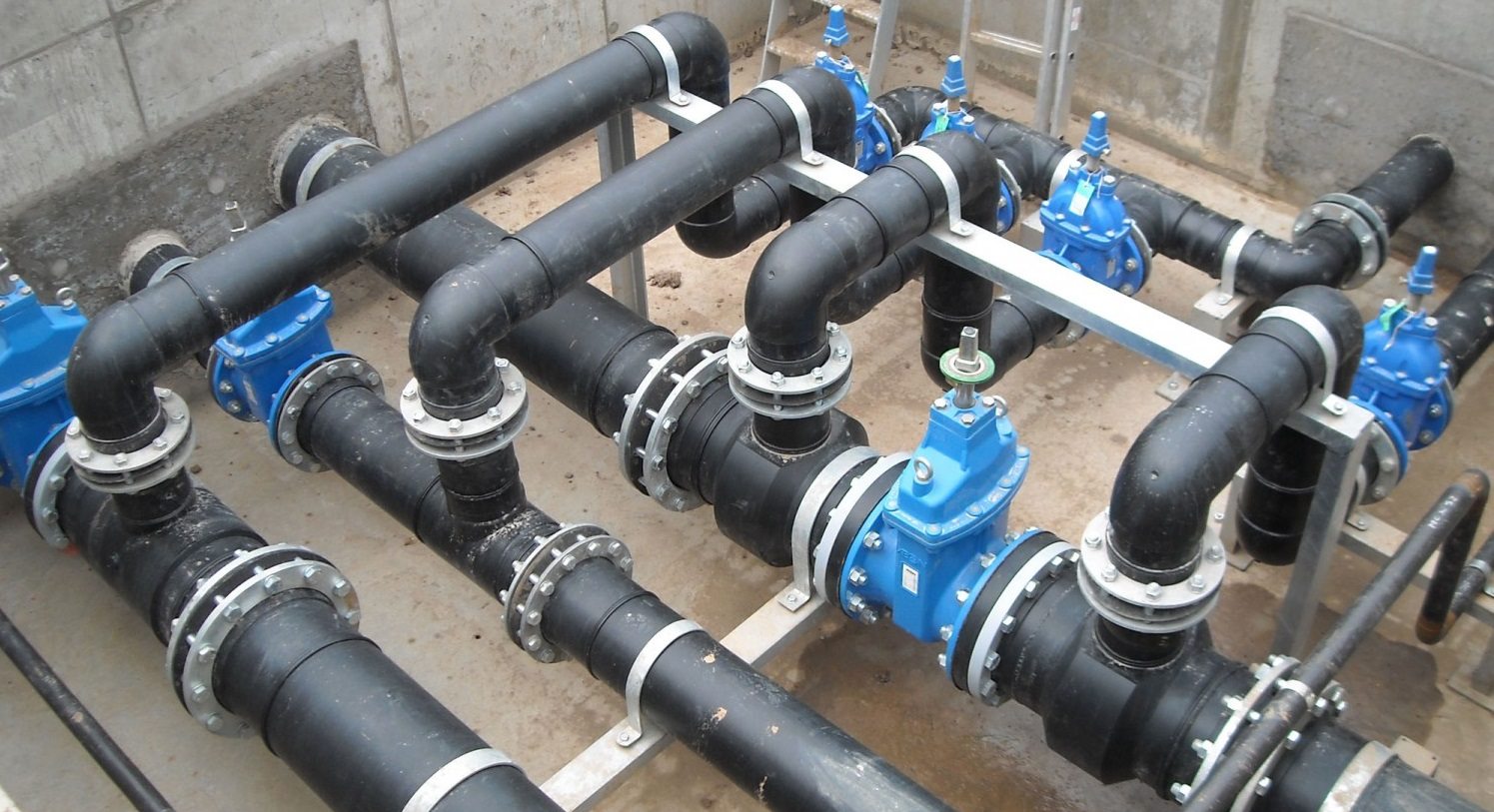
- Smooth inner walls create a minimum hydrodynamic resistance to fluid movement. This provides high throughput, and also prevents the deposition of silt and the formation of limescale in the pipe;
- High flexibility and plasticity of the material provide additional convenience during installation and operation:
- A flexible plastic pipeline of great length is easy to lay in an earthen trench;
- The heated plastic pipe can be bent to the desired radius, or given any curvilinear shape;
- Due to the elasticity of the side walls, polyethylene pipes do not burst when water freezes and an ice plug forms;
Polyethylene can be destroyed by ultraviolet radiation, so such pipes must be protected from direct sunlight. In order to limit the penetration of sunlight deep into the material, polyethylene for the manufacture of pipes is painted in a uniform black color.
Varieties of coupling connections
When installing a domestic sewer or domestic water supply, it often becomes necessary to join various pipes together along the length, connect them to the elements and assemblies of stop valves, or connect them to existing communications from steel pipes.
Usually, the installation of polyethylene pipes is carried out using couplings, which are made of the same material.
They are of three types:
- Electrofusion Couplings- allow you to perform non-separable connection of two or more pipes of the same or different diameters;
- Compression fittings - are intended for the same purposes, only in this case, the connection is collapsible;
- Flange connections- designed for joining along the length in the same plane, two pipes of the same or different diameters.
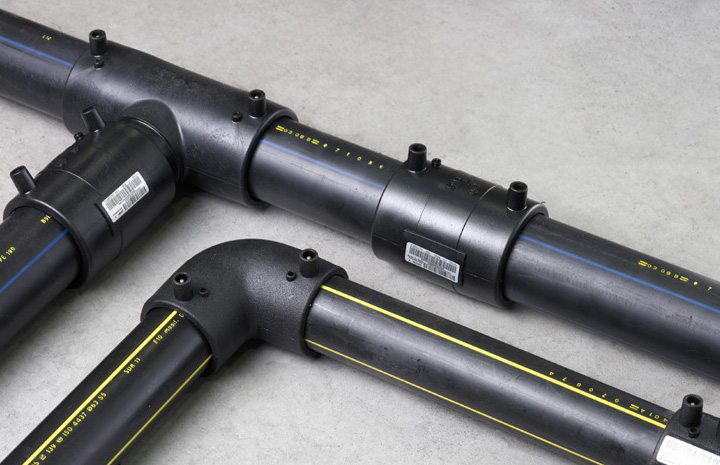
Depending on their purpose and design, all couplings and fittings for plastic pipes are conventionally divided into several types:
- Equal bore couplings designed for linear connection between two pipes with the same outer diameters;
- Expansion fittings serve to connect plumbing fixtures to a large-section main pipeline using plastic pipes of a smaller diameter;
- Flange connection fittings are used for joining metal and plastic pipelines of the same or different diameters;
- Side arms are used to change the direction of a pressure line that branches off from the main pipeline. The side outlet angle can be 30°, 45°, 60° or 90°;

- Crosses and tees are one of the varieties of side outlets. They serve to connect side branches of pipes in the same plane;
- Bypass pipes allow the intersection of two pipes with cold and hot water in the same plane;
- Threaded fittings are intended for connection of a plastic pipeline to metal pipes and shutoff valves with cut internal or external threads;
- Couplings with plugs are used for permanent or temporary overlapping of the pipe lumen. They are usually installed at the far blind end, or at the side standby branch of the pipeline.
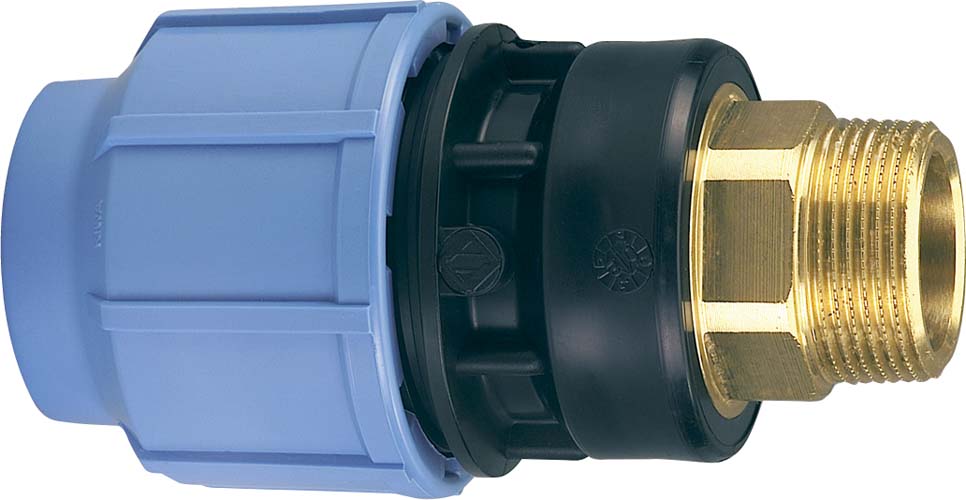
Polyethylene has one bad distinguishing feature. The fact is that not a single glue sticks to its surface, and not a single sealant normally sticks. Therefore, the use of glue in couplings, or the use of silicone sealant to seal joints, will be absolutely useless.
Method 1: Thermistor Welded Sleeves
Polyethylene has a melting point of about 120°-140° C. This makes it possible to hermetically connect polyethylene pipes by thermal diffusion welding. Two plastic pipes with the same outer diameter and a wall thickness of more than 5 mm can be butt-welded together, but this requires expensive and energy-intensive welding equipment.
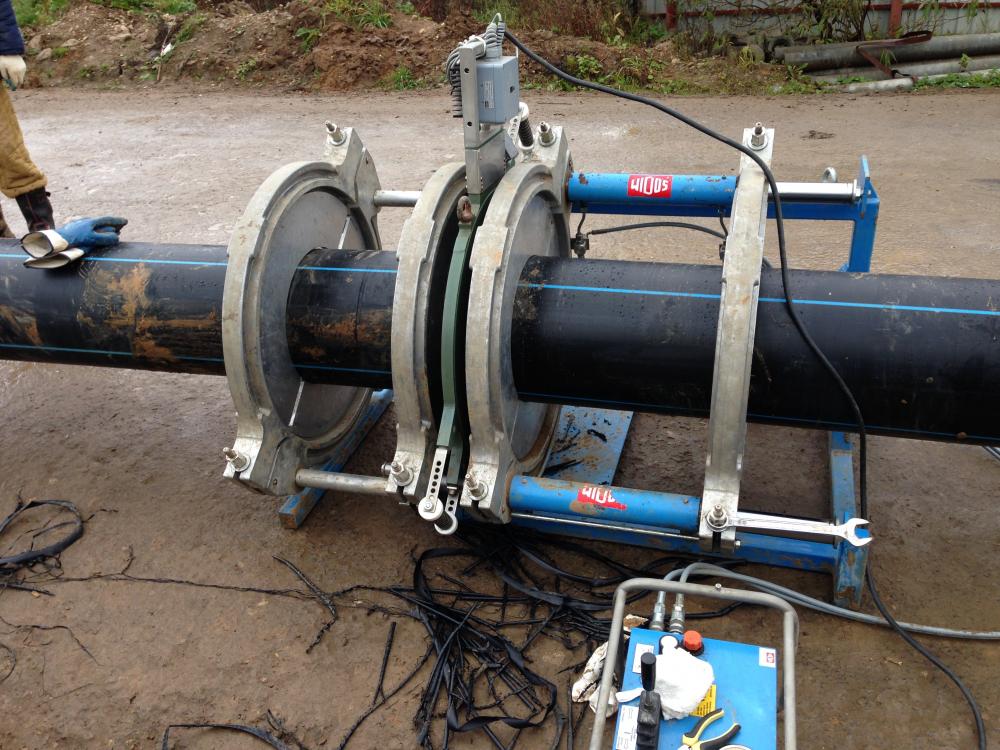
To solve this issue in a simpler way, thermistor couplings for polyethylene pipes are used. They are produced in various designs (equal bore, compensating, flanged, with side outlets, etc.), so they allow you to connect plastic pipelines of different diameters and attach side outlets to them at different angles.
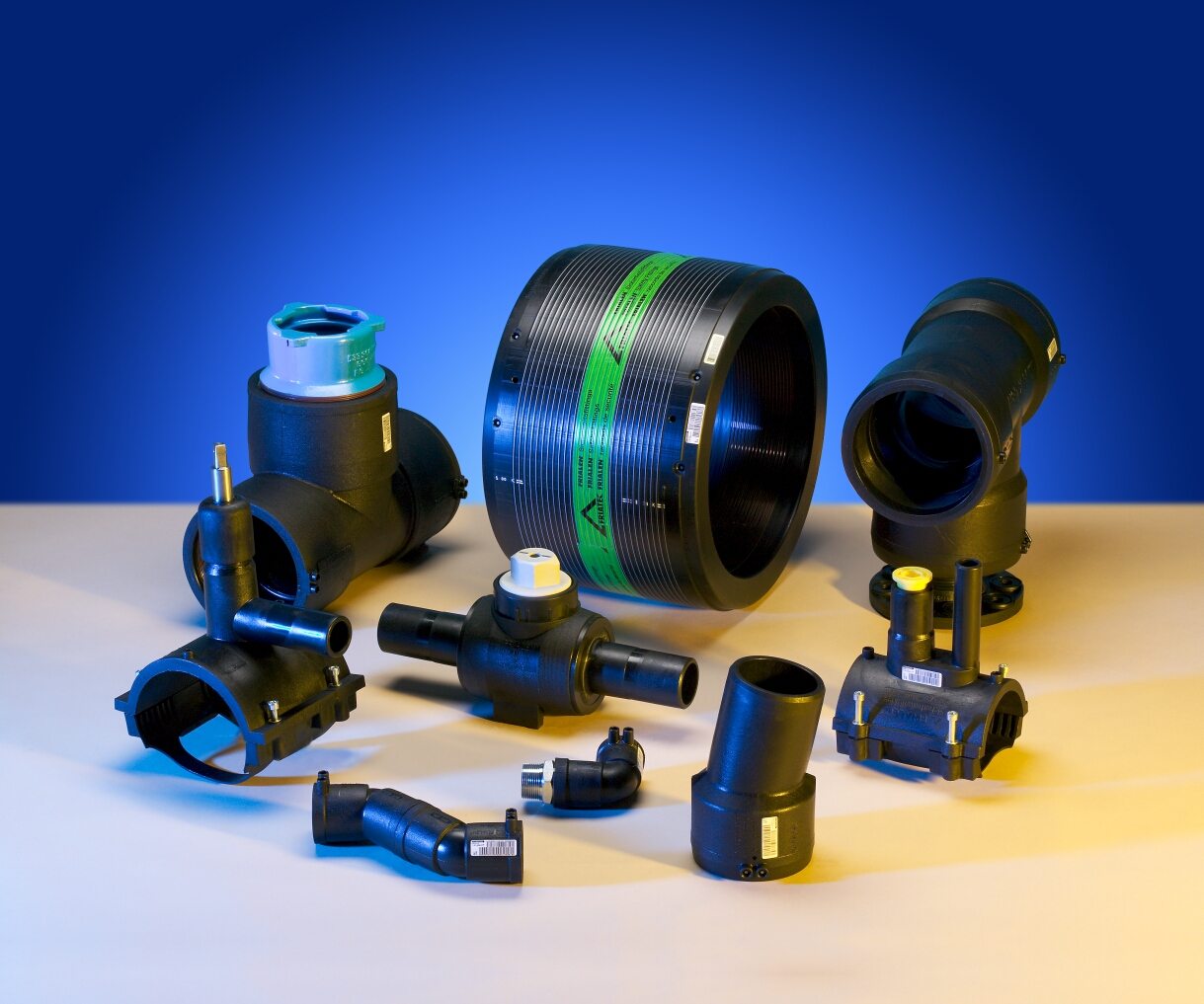
Despite the complex name, they have a very simple principle of operation and internal structure.
Below I will describe how this works, using the example of an equal bore thermistor coupling:
- Outwardly, it is a thick-walled short pipe, made of black low-density polyethylene;
- Inside the plastic case, around each connecting pipe, a spiral of metal wire with high electrical resistance (nichrome) is wound;
- Both coils are electrically connected in series.. The free ends of each spiral are connected to the terminals, which are located on the outside of the body, on both sides of the welded socket;
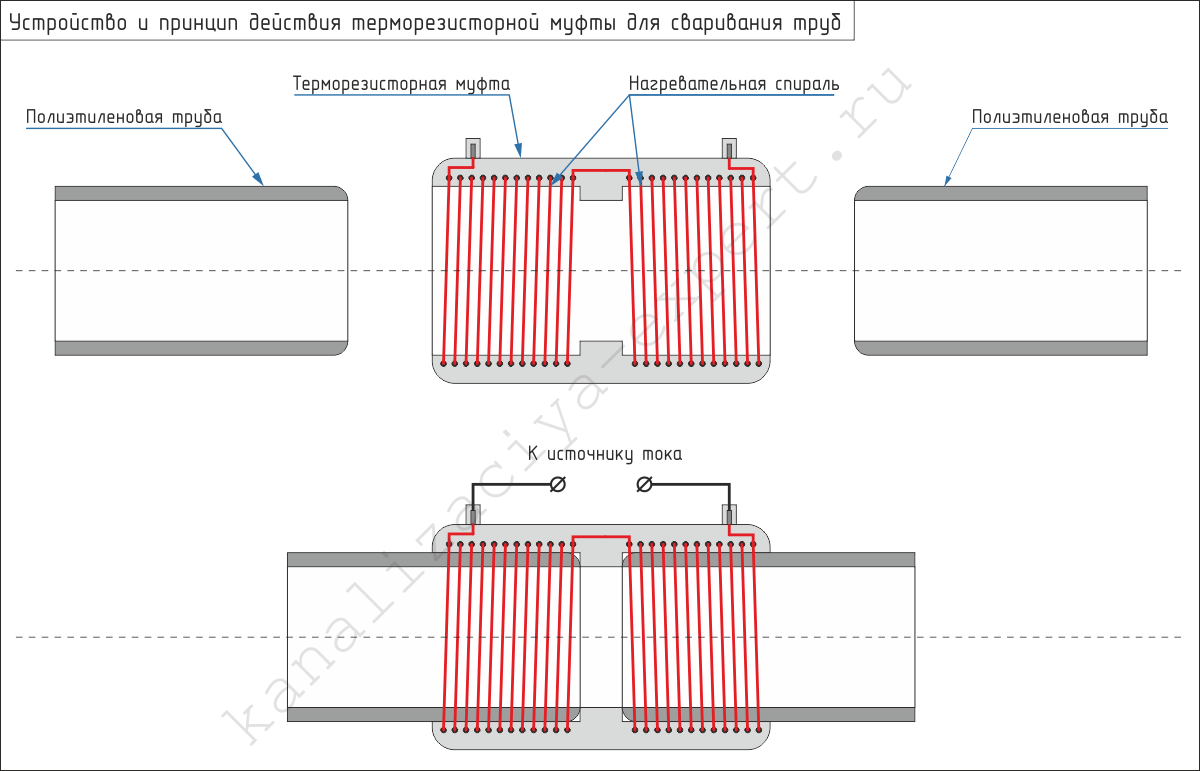
- The ends of the plastic pipes to be connected are inserted from both sides inside the welded socket. After that, voltage is applied to the terminals from an electric current source;
- Under the action of electricity, nichrome spirals inside the case are heated to the melting temperature of polyethylene. From heating, not only the inner part of the coupling melts, but also the outer surface of the pipes;
- As a result of melting, the plastic on the inside of the coupling expands and tightly compresses each pipe. After cooling, both pipes and the coupling are firmly welded together..
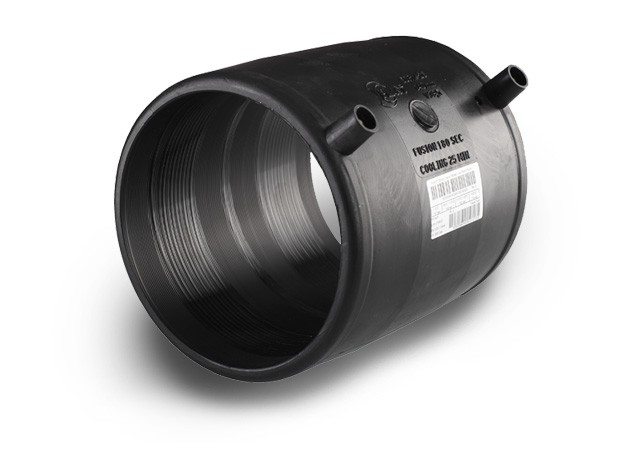
The described method allows you to connect plastic pipes with a diameter of up to 400 mm, although in domestic conditions, electric-welded couplings for pipes with a diameter of not more than 150 mm are most often used.
At first glance, the cost of an electrofusion coupling may seem high, but this technology has a number of obvious advantages over other methods of pipeline installation:
- Quick installation and easy use. Working with such devices does not take much time and does not require any practical skills;
- Low cost of work. The use of electrofusion couplings makes it possible to avoid the use of expensive and energy-intensive welding equipment;
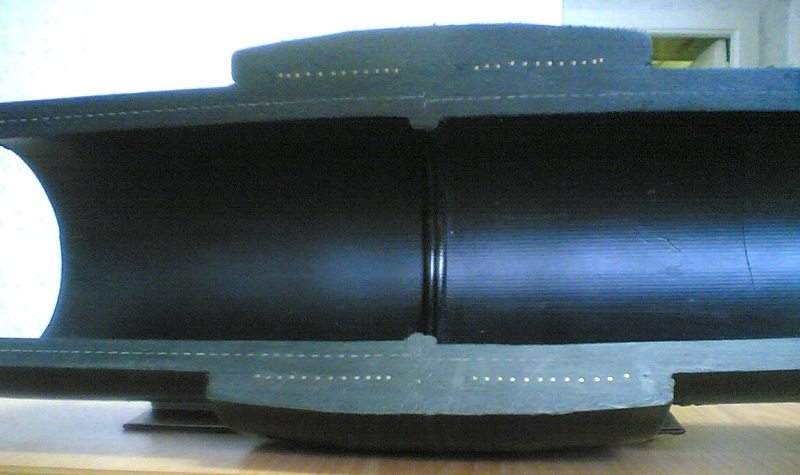
- High reliability and durability. The welded joint has high strength and is absolutely tight, and its performance does not deteriorate over time;
- Ability to work in hard-to-reach places. The electric welded coupling has a compact size, therefore, it allows you to easily install the pipeline right in the basement, in the manhole, in the earthen trench, and other hard-to-reach places;
- Ability to work offline. If it is not possible to supply electricity at the installation site, then a powerful battery or a portable gasoline generator can be used to connect the electrofusion coupling.
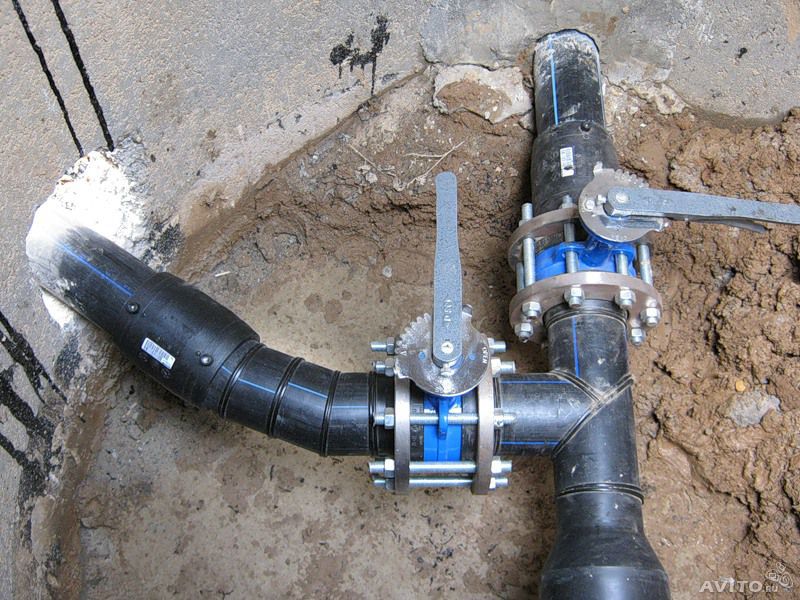
Despite all the positive qualities, this method has some limitations. For example, the operating temperature of the liquid in the pipe must not exceed 40°C, and the water pressure must not exceed 4 kg/cm². Therefore, electrofusion couplings cannot be used for the installation of domestic heating and hot water systems.
Pipe welding technology
High-quality installation of a pipeline made of plastic pipes is possible only with strict adherence to the polyethylene welding technology.
To assist the reader with this task, the following is a step-by-step guide to using thermistor electrofusion couplings:
- First of all, you need to cut the ends of the pipes to be welded so that so that their ends are strictly perpendicular to the center line. To do this, it is better to use a manual or electric pipe cutter;
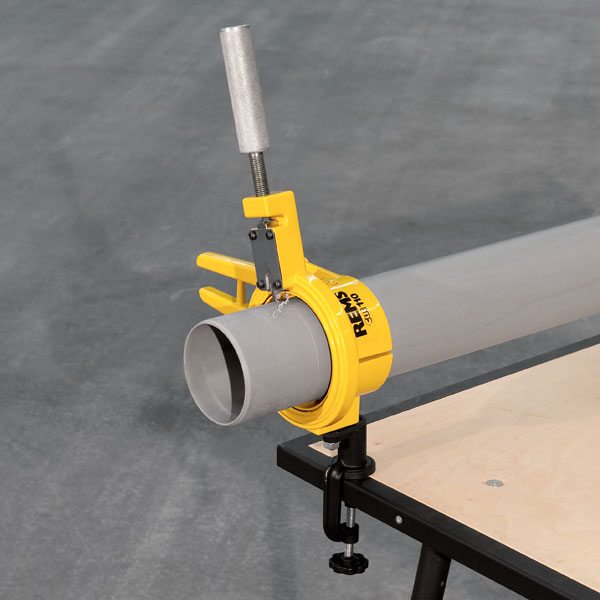
- Thoroughly clean the surface of dust and dirt, and then remove the thin top layer of plastic at the place of future welding. This can be done with a sharp knife or a special scraper;
- If the end of the pipe enters the coupling very tightly, then a small chamfer must be removed on its outer side. To do this, you can use a sharp knife or a special tool;
- If the wall thickness of the pipe is more than 5 mm, then I advise you to preheat it with a building hair dryer before welding;
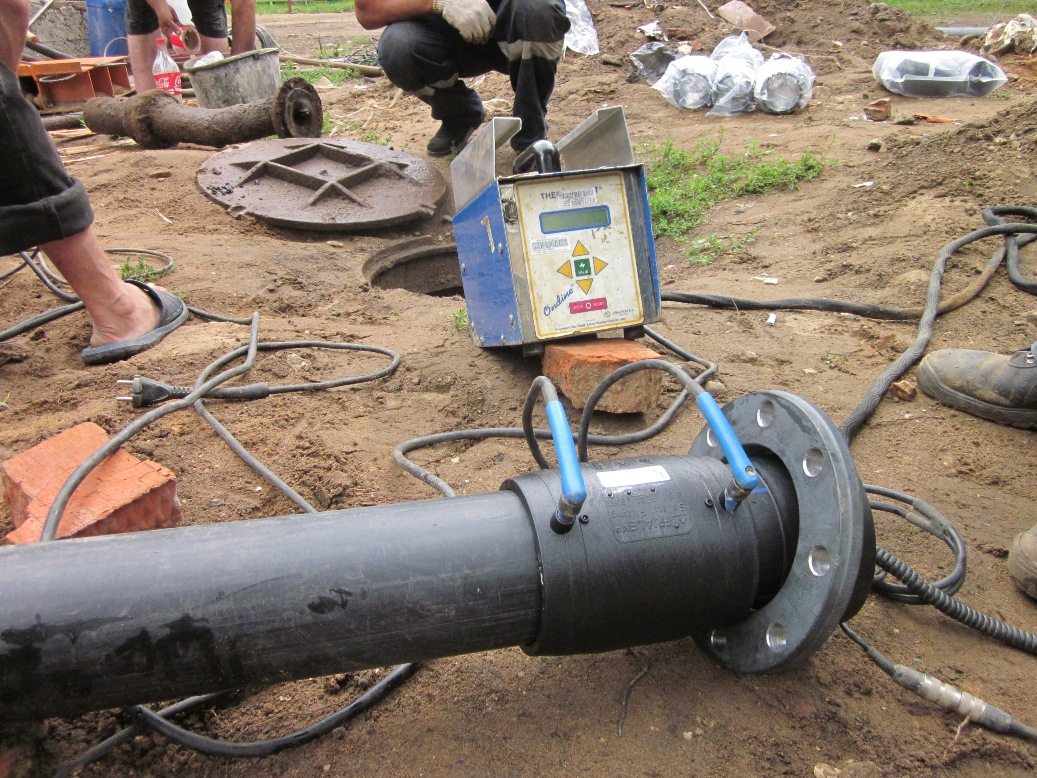
- After preparing the pipes, their ends must be brought inside the coupling from both sides until it stops. In this case, it is necessary to ensure that both pipes and the coupling are located strictly on the same axis;
- At this point, I recommend re-checking your pipeline configuration. If you make a mistake here, then to correct the error you will have to buy new components and redo all the work again;
- If everything is in order, then you need to connect both terminals on the clutch housing to a current source. To do this, you can use a powerful power supply, or a conventional welding machine with current and voltage control;
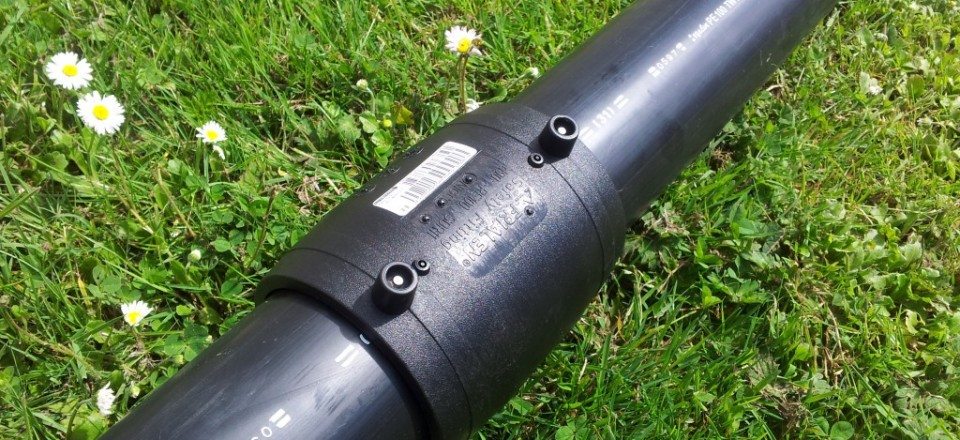
- The operating voltage and current consumption of electric coils is usually indicated on the factory marking of each welding socket;
- Usually welding of polyethylene is carried out in two stages:
- Heat. To do this, apply voltage to the terminals, then wait a while, and turn off the power supply.
- Cooling. After a power outage, the welded joint must be left motionless for 10-30 minutes;
- The exact heating and cooling time depends on the outside diameter of the pipe. This value can be seen in the table below.
The table shows the heating and cooling times for thermistor welding of polyethylene pipes.
To connect thick-walled pipes of large diameter, electrofusion couplings with three terminals are used - one in the middle and two at the edges. In this case, you must first insert one pipe inside the coupling, and connect the middle and outer terminals from the side of the pipe to electricity. After they are welded, you need to do the same with the second pipe, inserting it on the other side of the coupling.
Method 2: Compression Fittings
Connecting pipes using compression fittings is fundamentally different from the method described above. In this case, the coupling is not welded to the pipe, but is held on it solely due to the friction force. At first glance, such a connection may seem less reliable, however, it is not. According to the specifications, compression couplings can be used for the installation of pressure pipelines with a working pressure of up to 25 kg / cm².
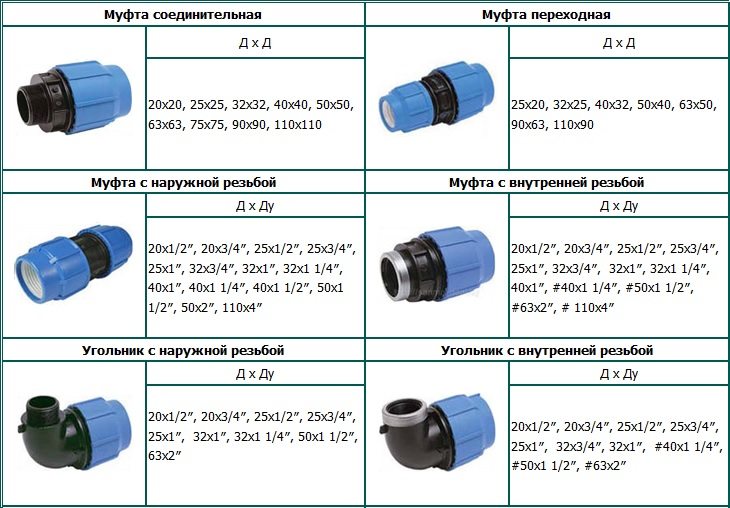
They are produced in a wide range of different models and sizes, so they allow you to solve almost any task of installing household utilities.
Fixation of the connected pipes in the compression fitting is carried out according to the principle of a collet clamp.
Its device and principle of operation is as follows:
- Coupling body for low pressure pipelines (up to 6 kg/cm²) is usually made of low pressure polyethylene;
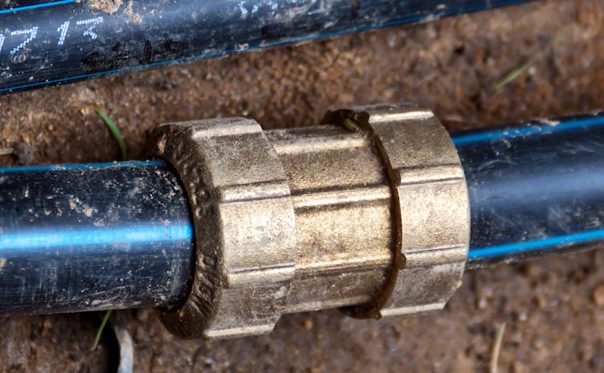
- Coupling bodies for connecting pressure pipelines with a working pressure of up to 25 kg / cm² are made of bronze, cast iron or brass;
- There is a thread on each side of the inlet pipe, on the outside of the body. A metal or plastic union nut is screwed onto it;
- Inside the case on each side there is one rubber sealing ring. They serve to seal the joints of the pipe end and the coupling body;
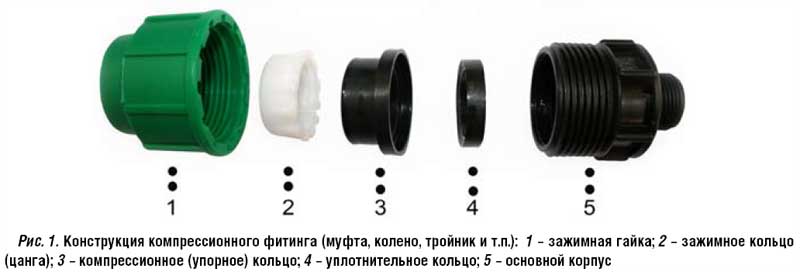
- A split collet sleeve is put on top of the end of each connected pipe. It is usually made from the same material as the clutch housing;
- A plastic pipe with a collet bushing is inserted into the body, and then pressed from above with a union nut;
- When tightening the union nut, the split petals of the collet sleeve are compressed around the pipe and firmly hold it inside the body due to friction.
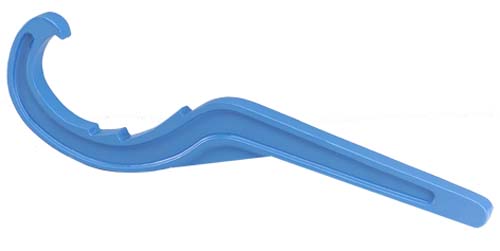
The maximum diameter of a plastic pipe for installing a compression fitting is 90 mm. For this reason, they cannot be used for installing domestic sewers, in which pipes with a diameter of 110 mm are usually used. At the same time, they are well suited for laying hot and cold water supply networks, automatic irrigation systems, and other pressurized water communications.
Fitting connections of plastic pipes have the following positive qualities:
- Relatively low cost. Depending on the size and design, the price of one fitting can be from 220 to 2350 rubles;
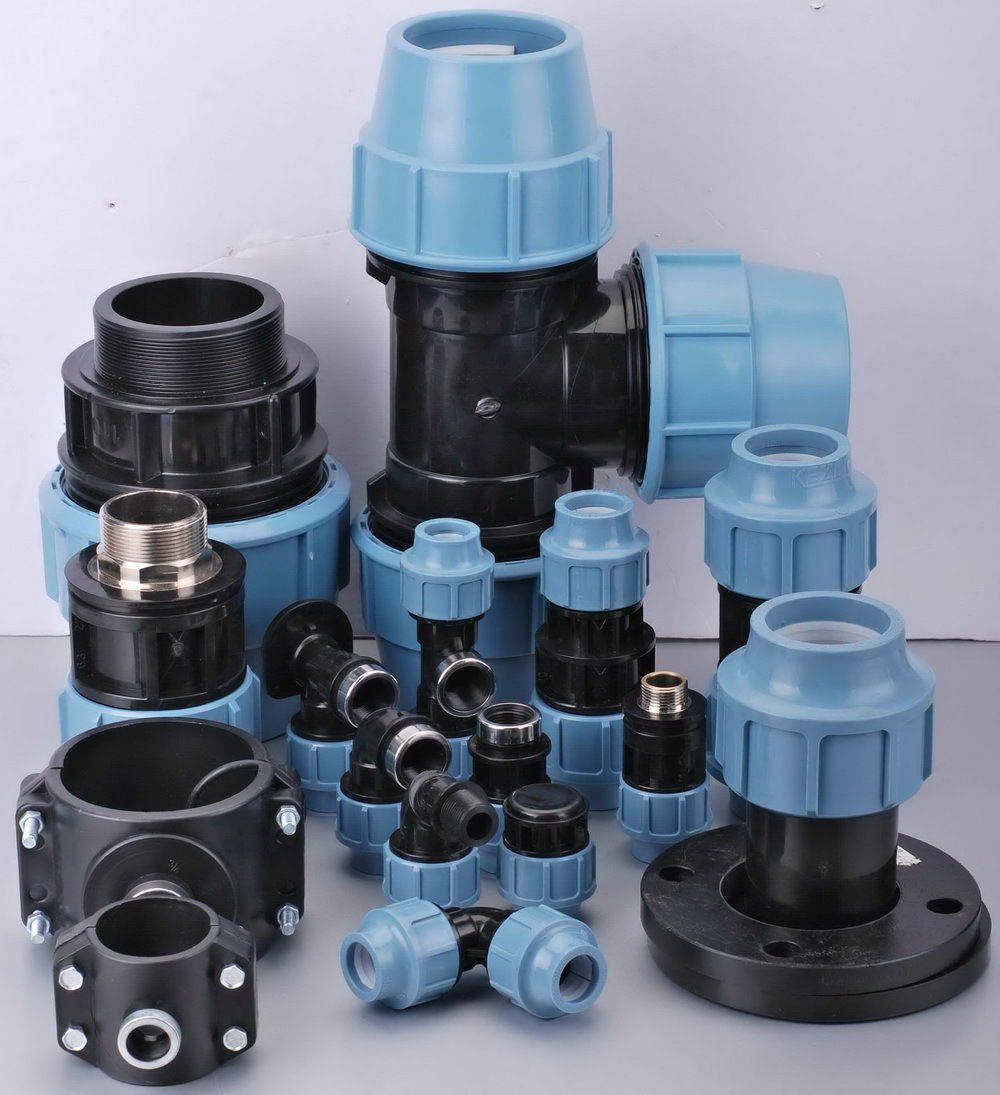
- Simple and fast installation. The installation of clamp fittings does not require an electrical connection and does not require the use of any special tools;
- maintainability. If any part of the fitting fails (for example, the collet sleeve bursts or the sealing ring breaks), then it can be replaced with a new one at any time;
- Collapsible connection. The use of collet fittings allows you to quickly change damaged sections of pipes, or change the configuration of the entire pipeline;
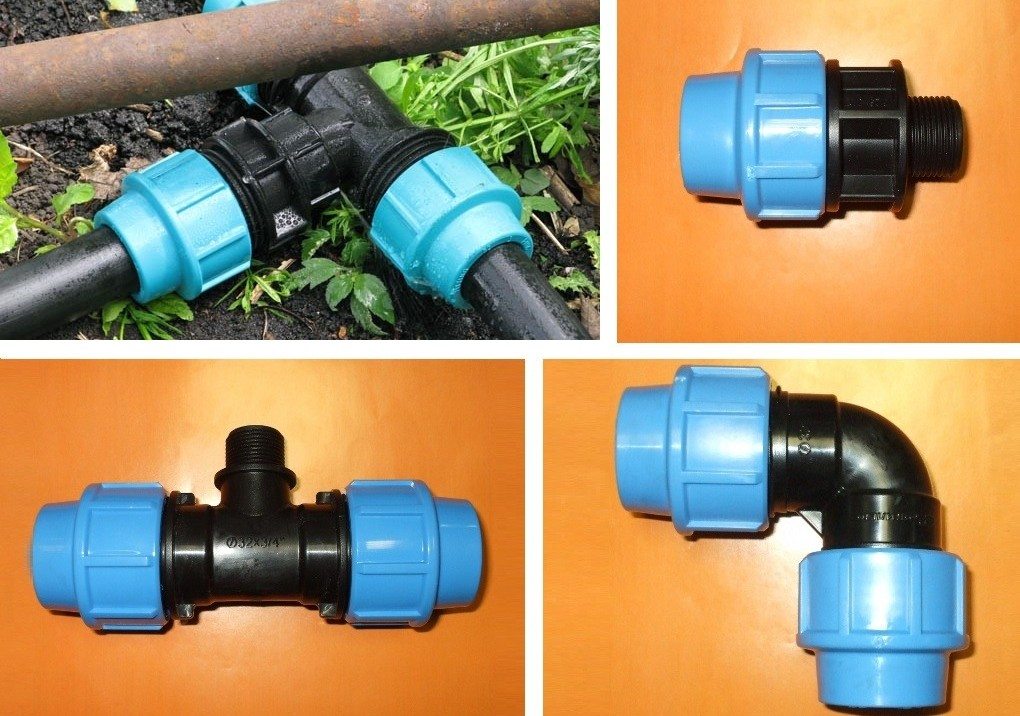
- Reusability. If necessary, compression fittings can be installed and dismantled an unlimited number of times;
- Chemical resistance and durability. All fitting parts are made of corrosion-resistant materials that do not oxidize in water and do not contribute to the formation of limescale;
- Reliability and high durability. The collet connection of pipes is capable of withstanding significant dynamic loads that may occur during hydraulic or steam shocks.
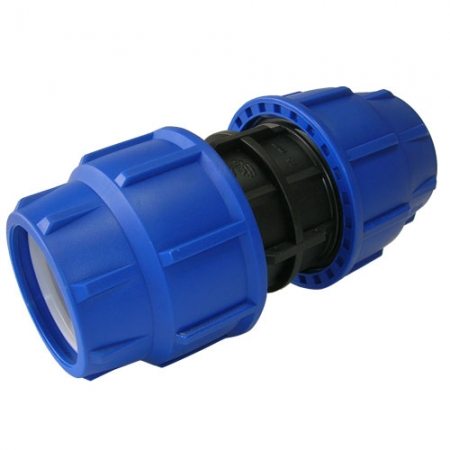
There is a cheaper type of compression fitting, which is called a coupling. It has a simpler design, and is used for splicing along the length of two plastic pipes of the same diameter.
Features of installing fittings
Installation of compression fittings is considered the easiest way to connect plastic pipes. All you need to do this job is a sharp knife and a small tube of silicone.
- To ensure a tight tight connection, the surface at the ends of the pipes must be cleaned of dust and dirt, and then wiped with a clean, dry rag;
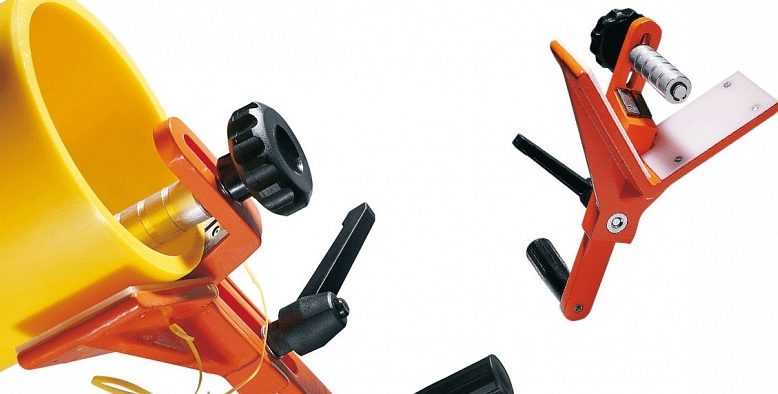
- At the end of each pipe, remove a small chamfer. This can be done with a sharp knife or a special tool that is sold in plumbing stores;
- Unscrew the union nuts on both sides of the fitting, and then pull out the collet bushings and sealing rings from the body;
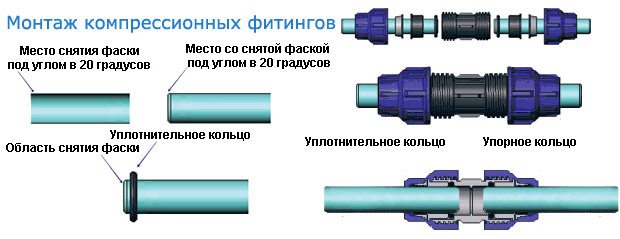
- After that, all components must be put on each pipe in the following sequence:
- First of all, a union nut is put on, with the threaded side to the end of the pipe;
- After that, a split collet sleeve is put on;
- At the very end, a rubber o-ring is put on.
- To make the rubber ring and bushing easier to put on, I recommend lubricating the surface of the pipe with silicone sealant. If you do not have a sealant, then liquid soap can be used for this;
- After that, both pipes with collet bushings must be inserted inside the fitting body, and both union nuts should be screwed with maximum force.
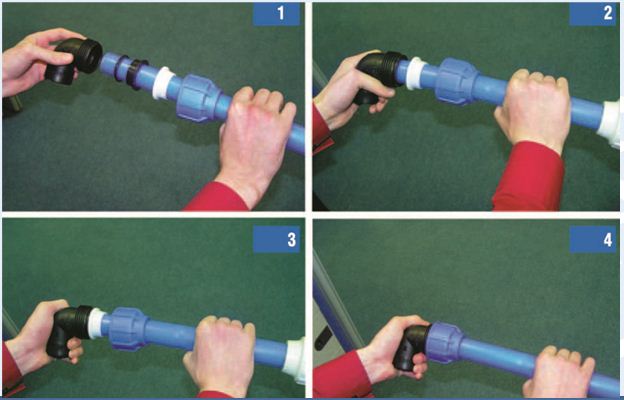
Polyethylene under high temperature conditions has insignificant heat-shrink properties, therefore, on the DHW pipeline, the walls of the plastic pipe may shrink over time. In order for the connection of polyethylene pipes with fittings to remain tight, it is necessary to periodically check and tighten the union nuts on the collet bushings.
Method 3: Flange connection
In domestic water networks, flanged connections are not common. In most cases, they are installed at the entrance to the building, or are used to join two large pressure pipes.
The principle of operation and the device of such a connection is very simple, so it can be easily assembled with your own hands:
- A flat metal round flange is rigidly fixed at the end of each pipe;
- Most often it is sold assembled with a compression fitting, therefore it is attached to a plastic pipe using a collet clamp. If necessary, it can also be secured using an electrofusion socket;
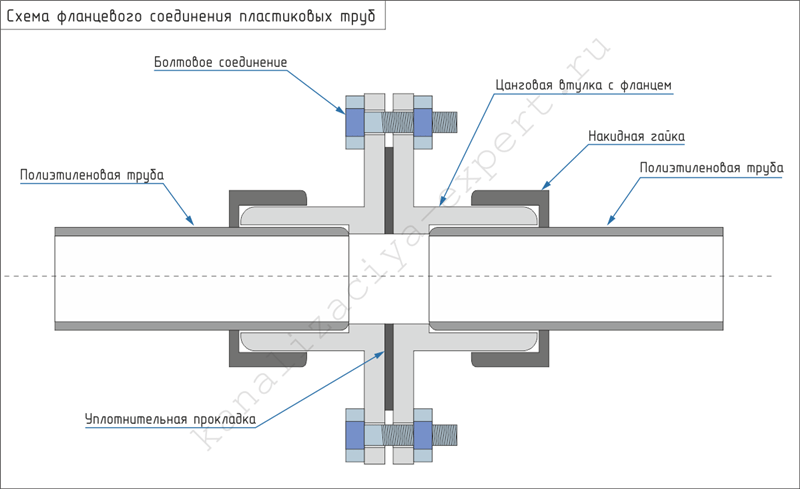
- In the diametrical plane of the flange, several mounting holes are located radially along the circumference;
- During installation, it is necessary to install a sealing gasket made of paronite or thick rubber between the flanges;
- After that, it is necessary to combine the mounting holes on the flanges, and tightly tighten them together with ordinary bolts and nuts.

As a rule, a flanged connection has bulky dimensions and an unsightly appearance, therefore it is mainly used for the installation of hidden communications in basements, viewing rooms, etc.
At the same time, this method has its obvious advantages:
- High reliability and absolute tightness. Due to these qualities, flange connections are used in the installation of main water supply networks, and in the laying of pressure sewer lines;
- Ease of maintenance and maintainability. If any section of the pressure pipeline needs periodic maintenance, I recommend connecting to the main pipe using bolted flanges;
- As examples, I can cite inspection hatches, expansion tanks, storage tanks, siphons and check valves for sewage, etc .;

- Universal mounting method. Many plumbing fixtures and metering units (for example, valves, gate valves, circulation pumps, water meters, etc.) are equipped with connecting flanges of standard sizes at the inlet and outlet;
- To dock these devices with a plastic pipeline, collet couplings with a mating metal flange are used;
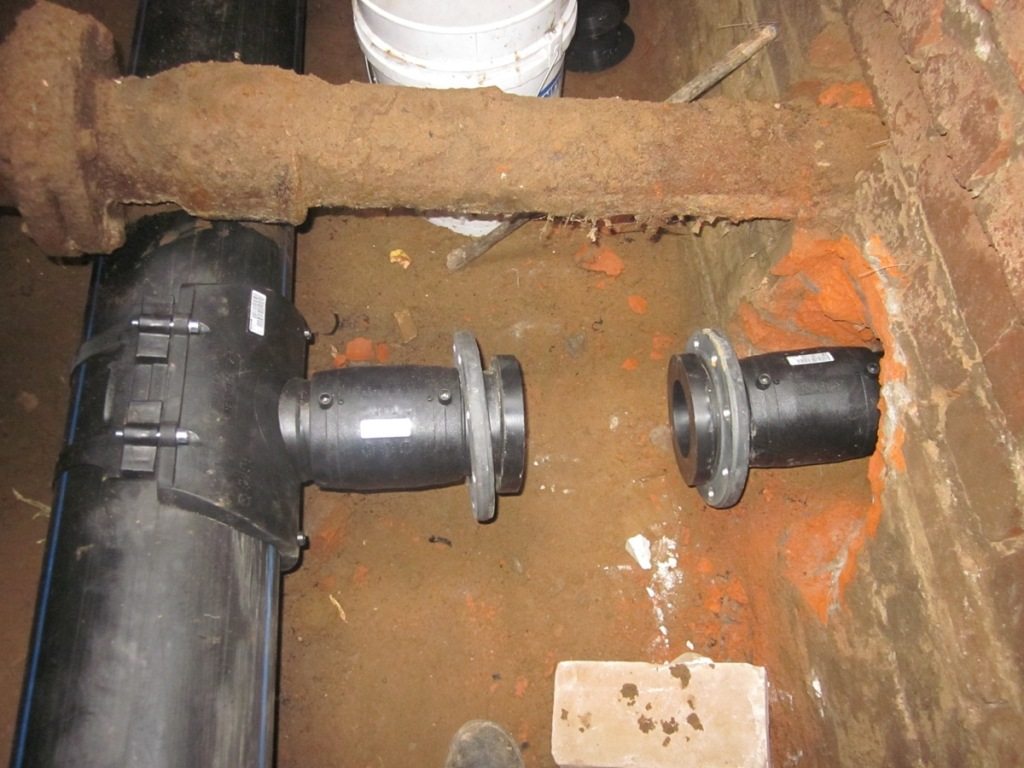
There are also protective and repair couplings. The protective sleeve is a thick-walled polyethylene pipe that is put on the pipeline at the points of passage through the building structures of the building (foundation, floors, walls, etc.). The repair sleeve consists of several individual segments. They are superimposed on the damaged section of the pipeline, and are fixed with clamps, bolts or welding.
Conclusion
Based on the materials of this article, you were able to get acquainted with three simple and affordable ways to connect polyethylene water pipes. If you still have something that is not entirely clear, I recommend watching the video in this article, and I am ready to answer all your questions in the comment form.


















